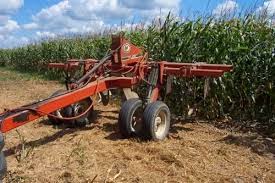Almost 30 years ago I became the Agriculture agent in Warren County. I quickly met the county's farmers and was included in a plot with SWCD on the Spellmire Farm in Lebanon, Ohio. I was cleaning files and found the plot results and thought it would be interesting today.
This county and a few farmers like the Spellmire's were already "sold" on no-till and were working to adapt on their farms and improve it. I fit right into that equation since we had started no-tilling in 1976.
When I met them, they had just bought the first "paratill" implement in the area, the first one I ever saw. Tye Company built a deep soil ripper that left the surface pretty much untouched, just a gentle rise of soil above the soil where the leg had fractured the soil below the plow layer. Plow layers were common in 1987 and still are today. Many Ohio and other Midwest soils have a natural fragipan layer formed when the last glacier had passed through.
They wanted to compare the effects of the major types of preparing the soil for the seed furrow so they set up this experiment they ran many times on many different fields with different types of soil and management conditions.
This plot turned out like this:
paraplow no-till 162.7
no-till 152.5
moldboard plow and disk 155.6
disk twice 149.9
chisel plow, disk 153.4
The test was replicated 4 times across the field and the results was the average of those strips.
The first thing you notice is the yields compared to today. Those were good yields 25 years ago. We noticed the least erosion in the paraplow no-till and the no-till. The field had a pretty good roll to it and there was washing in any of the tillage methods.
The idea never really caught on but a few farmers still paraplow.
I hope you enjoyed this "blast from the past" today. This kind of information has helped us slowly adapt better practices over the past 25 plus years.
Ed Winkle
Subscribe to:
Post Comments (Atom)


ReplyDeleteSimscott LathemFarms Very interesting yield results. Thanks for sharing. We currently use the Paratill. This pic is wheat cover crop behind potatoes. We will water it behind the plow to settle the sand back down, then plant it to corn. It works great for us.
This is where I think a Vertical Till unit would fit in. Run this paratill ripper in the fall and use the VT tool to level out the small ridges left. If on a C/B 50/50 rotation every 4 or 6 years IMO would potentially help. Depending on soil conditions.
ReplyDeleteTough to pay for one of those overpriced disk tho.
-Brian Burnell
The tandem disk harrow has very slowly lost popularity but you still see a few around! There are so many other combination tillage tools sold out there I couldn't begin to count them all!
ReplyDeletekyrie 7
ReplyDeletelebron 17 shoes
off white
yeezy
yeezy 500
pandora
kyrie shoes
supreme clothing
lebron 16
hermes birkin
best replica ysl bags replica bags cheap replica bags canada
ReplyDelete